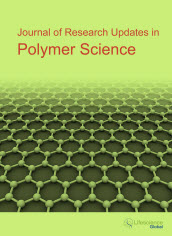jrups
Abstract : Effect of Cenosphere Fly Ash on the Thermal, Mechanical, and Morphological Properties of Rigid PVC Foam Composites
|
|
Abstract: Cenosphere fly ash is a byproduct of coal combustion processes of power plants. It is composed of hollow, hard shelled, minute spheres, which are made up of silica, iron, and alumina. In this study, cenosphere fly ash is incorporated into rigid PVC foam to improve thermal and mechanical properties of their composites. Microstructural, physical, mechanical, and thermal properties of rigid PVC foam extruded with different loadings of cenosphere fly ash (6, 12, 18phr) are characterized. The measured density of the extruded PVC foam composites increased with cenosphere content, indicating a hindrance to the foaming process. Tensile and flexural mechanical properties improved at higher cenosphere content, while the impact strength decreased at initial loading of 6 phr of cenosphere particles and remained steady at higher loadings. Thermal characterization of the extruded samples showed that glass transition temperature remained almost unaffected, while TGA analysis revealed no change in the initial degradation temperature and significant improvement in the final degradation temperature. Thermo-mechanical properties measured by DMA revealed a remarkable improvement in the viscoelastic properties of the composites reinforced with cenosphere particles. SEM analysis of the composites microstructure confirmed that the cenosphere particles were mechanically interlocked with good interfacial interaction in the PVC matrix. Keywords: Polyvinyl Chloride Foam, Fly ash, Characterization, Tensile, Flexural, DMA, SEM, XRD, TGA, DSC.Download Full Article |
Abstract : Coloration of Polyester Fibers for Securities Protection from Counterfeit
|
|
Abstract: The results of modifying polyester fibers with luminescent colorants by crazing mechanism have been given. By means of REM and AFM stages of crazes initiation, their transformation into fibrillar structure of fiber and redistribution of modifiers incorporated into crazes in the surface layer of fiber have been revealed. Techniques of concentrating luminescent colorants on local sections of fiber with alternation of unprocessed segments and segments containing target additives have been described. Polyester fibers with alternating by length sections of luminescent division of colors have been obtained. It was shown that effective fiber coloration takes place when the drawing out degree ε* is between 2 and 3. Fibers modified by Oxazine and Rhodaminecolorants are characterized by highest intensity of luminescence in UV radiation. The conclusion has been made that technology of modifying chemical fibers by cazing mechanism allowing implementing measured incorporation of target additives on local sections of fiber satisfy in the optimal way the protection criteria of paper filled with such fibers from counterfeiting. Keywords: Chemical fibers, modification, crazing, protection, colorants, luminescence.Download Full Article |
Abstract : Morphology and Properties of Hydrogenated Nitrile Rubber/Poly Hydroxyl Zinc Monomethacrylate Composites by Curing with Peroxide
|
|
Abstract: The morphology evolution of hydroxyl zinc monomethacrylate (HZMMA) in hydrogenated nitrile rubber (HNBR) during its formation, and effect of synergistic behavior of HZMMA and carbon black (CB) in HNBR on its properties, were investigated. Fourier transform infrared spectroscopy (FTIR), differential scanning calorimetry (DSC), transmission electron microscopy (TEM) and X-ray diffraction (XRD) were used to probe the reaction of in-situ polymerized HZMMA. The results showed that an ionic polymer interpenetrating HNBR, due to homo-polymerization or graft polymerization of HZMMA solid monomer occurred, and poly-HZMMA particles, confirmed by FTIR and TEM, were formed during the HNBR vulcanization process. This kind of morphology for the HNBR composites played a very significant role in the HNBR reinforcement. At ambient temperature, the mechanical properties of HNBR composite filled with pure PHZMMA was much superior to those of the HNBR/PHZMMA/CB composites; however, when the temperature was increased to above 50°C, the decrease of the tensile strength for the latter was slower, and the tensile strength was always higher than that of the HNBR composites reinforced with pure PHZMMA at the same temperature. The elongation at break above 80°C was also always higher than that of the HNBR/PHZMMA sample. The HNBR/PHZMMA/CB composites showed excellent air oven aging resistance. Keywords: hydrogenated nitrile rubber, hydroxyl zinc monomethacrylate, morphology, properties.Download Full Article |
Abstract : Quaternized and Unmodified Chitosans: Hydrodynamic Properties
|
|
Abstract: Molecular properties of N-[(2-hydroxy-3-trimethylammonium)propyl]chitosan (modified chitosan) series with the averaged quaternization degree 90% have been studied in comparison with the unmodified chitosan series by the method of translation isothermal diffusion, viscometry and static light scattering in dilute solutions in 0.33М СН3СООН+0.2М CH3СООNa at pH 3.54. Molecular mass, translation diffusion coefficient, and hydrodynamic size of the homologues samples in the modified/unnmodified series have been determined as well as their chain rigidity and Mark-Kuhn-Houwink equations at acidic pH. It was established that the size of modified chitosan molecules might be smaller than the initial polysaccharide of an equal polymerization degree in the same solvent, which was explained by the change of thermodynamic conditions and the change of the ratio of thermodynamic/electrostatic contributions to the total chain rigidity. Quaternized chitosan molecules displayed the different hydrodynamic behavior in 0.33М СН3СООН+0.2М CH3СООNa and in 0.2M NaCl (neutral pH). Solution properties of quaternized chitosan at neutral pH had been identified as the concentration dependent. The threshold influence of the secondary amino group protonation on the hydrodynamic properties of modified chitosan molecules was detected in 0.2M NaCl at the solute concentration range 0.001-0.004 g/cm3. Keywords: Polysaccharides, chitosan, quaternization, hydrodynamic behavior.Download Full Article |






















